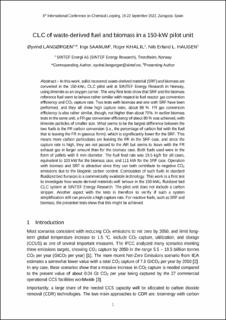| dc.description.abstract | In this work, solid recovered waste-derived material (SRF) and biomass are
converted in the 150-kWth CLC pilot unit at SINTEF Energy Research in Norway,
using ilmenite as an oxygen carrier. The very first tests show that SRF and the biomass
reference fuel seem to behave rather similar with respect to fuel reactor gas conversion
efficiency and CO2 capture rate. Two tests with biomass and one with SRF have been
performed, and they all show high capture rates, about 98 %. FR gas conversion
efficiency is also rather similar, though, not higher than about 70%. In earlier biomass
tests in the same unit, a FR gas conversion efficiency of about 80 % was achieved, with
ilmenite particles of smaller size. What seems to be the largest difference between the
two fuels is the FR carbon conversion (i.e., the percentage of carbon fed with the fuel
that is leaving the FR in gaseous form), which is significantly lower for the SRF. This
means more carbon particulates are leaving the FR in the SRF case, and since the
capture rate is high, they are not passed to the AR but seems to leave with the FR
exhaust gas in larger amount than for the biomass case. Both fuels used were in the
form of pellets with 8 mm diameter. The fuel feed rate was 19.5 kg/h for all cases,
equivalent to 103 kW for the biomass case, and 111 kW for the SRF case. Operation
with biomass and SRF is attractive since they can both contribute to negative CO2
emissions due to the biogenic carbon content. Combustion of such fuels in standard
fluidized bed furnaces is a commercially available technology. This work is a first test
to investigate how waste-derived materials will behave in the 150-kWth fluidized bed
CLC system at SINTEF Energy Research. The pilot unit does not include a carbon
stripper. Another aspect with the tests is therefore to verify if such a system
simplification still can provide a high capture rate. For reactive fuels, such as SRF and
biomass, the presented tests show that this might be achieved. | en_US |

